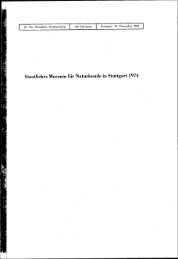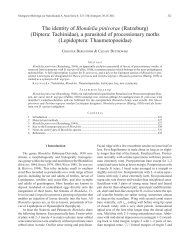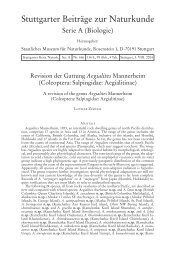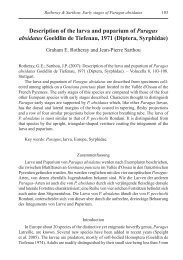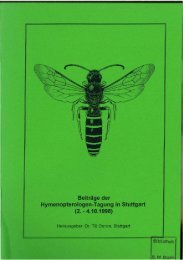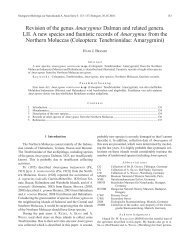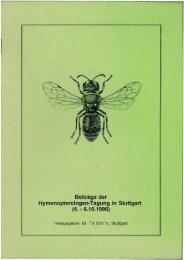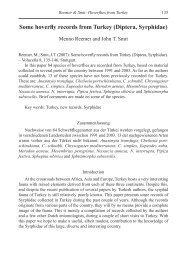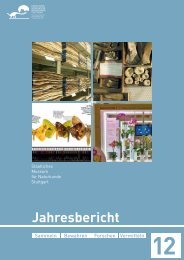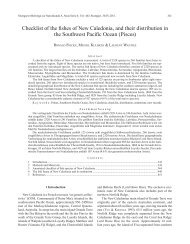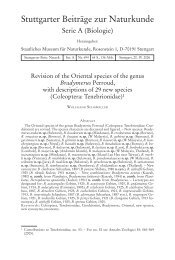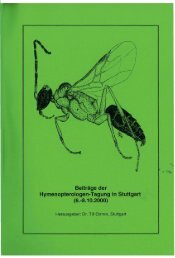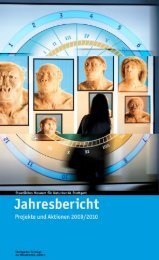166 STUTTGARTER BEITRÄGE ZUR NATURKUNDE ANeue Serie 6acute angles, frons with distinct supraorbital furrows andwith distinct supraorbital keels. Last 6 antennomeres forminga club. Anterior corners <strong>of</strong> pronotum distinctly protruding,lateral margin with feeble crenulation, pronotal discconvex, with dense and partly confluent punctation, beforebase in the middle with a large impunctate field, betweenpunctures with several granules; pronotum medially withweak longitudinal impression. Elytra with punctural rowswithout striae, punctures deeply impressed, intervals flat,intervals 1, 3, 5, 7 and 9 with a row <strong>of</strong> distinct elongategranules, posteriorly tubercles confluent and keeled. Tibiaeexternally with distinct keels; male tibiae without modifications.Aedeagus see Fig. 46.Synonymy: <strong>The</strong> reexamined type series <strong>of</strong> B. buruensiscompletely coincides with the description and figure<strong>of</strong> B. regularis by GEBIEN (1922). When describing B.buruensis, KULZER (1951) mentioned the similarity to B.regularis and separated the two <strong>species</strong> only by the shape<strong>of</strong> the high supraorbital keels and by the shape <strong>of</strong> the broadgenae, but these tiny differences are not specific. Thus, B.buruensis Kulzer, 1951 is considered a junior synonym <strong>of</strong>B. regularis Gebien, 1922.Distribution: New Guinea (type locality Mt. Victoria<strong>of</strong> B. regularis); Buru (type locality <strong>of</strong> B. buruensis),Seram (Moluccan Islands).<strong>Bradymerus</strong> rugipleuris Gebien, 1922(Figs. 11, 57)Studied type material: Great Banda Island (SSeram), 1 ♂ syntype NHMB, here designated as lectotype.Examined material: Bacan Island, valley 3 km SLabuha, 40 m, 13.I.2006, leg. A. WEIGEL, 1 ex. SMNS. – MorotaiIsland, W Daruba, Raja, 50–300 m, 16.–19.XI.1999, leg. A. RIE-DEL, 2 ex. SMNS. – NE Halmahera, 5 km E Labi Labi, 2.VI.1997,leg. M. HIERMEIER, 5 ex. CRGT. – NW Halmahera, 7 km S Jailolo,200 m, 27.I.2006, leg. A. WEIGEL, 2 ex. NME.Diagnostic characters: Dorsal view seeFig. 11, dorsal side blackish without metallic shine, bodylength 9.5–11.0 mm. Genae not broader than eyes, fronswith distinct supraorbital furrows but without distinct supraorbitalkeels. Last 5 antennomeres forming a club. Anteriorcorners <strong>of</strong> pronotum distinctly protruding, lateralmargin with feeble crenulation, pronotal disc swollen, withdense and partly confluent punctation, before base puncturesmore separate, between punctures without granules;pronotum before base with shallow transverse impressionand medially with shallow longitudinal impression. Elytrawith punctural rows without striae, punctures deeply impressed,interval 1 flat, intervals 2–8 with complete keels.Tibiae externally without distinct keels; anterior maletibiae internally with two narrow longitudinal stripes <strong>of</strong>densely set light setae. Aedeagus see Fig. 57.Distribution: Bacan (= Batjan) Island, Banda Island(type locality), Morotai, Halmahera (Moluccan Islands).<strong>Bradymerus</strong> sculptilis Kulzer, 1951(Figs. 13, 58)Studied type material: Papua New Guinea, BolanMts., 1 ♂ paratype NHMB.Examined material: Papua New Guinea (labelled asD. N. Guinea), Wareo, 12 ex. MNB. – Papua New Guinea, BolanMts., no further data, 3 ex. SMNS. – Papua New Guinea, EasternHighlands Prov., Kainantu, Onerunka, VII.1981, leg. W. G. ULL-RICH, 1 ex. CKAO. – Papua New Guinea, Madang Distr., FinisterreMts., 5550 ft., 30.X.–15.XI.1964, collector unknown, 3 ex.BMNH. – Papua New Guinea, Eastern Highlands Prov., Okapa,5000 ft., 4.–15.II.1965, collector unknown, 1 ex. BMNH. – PapuaNew Guinea, Eastern Highlands Prov., Okapa, II.2003, collectorunknown, 1 ex. CKAO. – Papua New Guinea, Southern HighlandProv., Tari to Koroba, Hake, 1700–2000 m, 14.V.1998, leg. A.RIEDEL, 2 ex. SMNS. – West Papua, Anggi, Iray, Gunung Disbehey,1900–2100 m, 19.–20.III.1993, leg. A. RIEDEL, 2 ex. SMNS.– West Papua, Minyambou, 1500–1900 m, 13.–14.IV.1993, leg.A. RIEDEL, 5 ex. SMNS. – West Papua, Manokwari Prov., Mokwam,1300–1600 m, 17.IV.1993, leg. A. RIEDEL, 1 ex. SMNS. –West Papua, Arfak Mts., Mokwam (Siyoubrig), 1400–1800 m,24.–28.II.2007, leg. R. GERSTMEIER, 1 ex. CRGT. – West Papua,Manokwari Prov., Mokwam (Siyoubrig), 1400–1800 m, 24.–28.II.2007, leg. A. WEIGEL, 1 ex. NME.Diagnostic characters: Dorsal view seeFig. 13, dorsal side blackish without metallic shine, bodylength 8.5–11.5 mm. Genae not broader than eyes, fronswith distinct supraorbital furrows but without distinct supraorbitalkeels. Last 6 antennomeres forming a club. Anteriorcorners <strong>of</strong> pronotum distinctly protruding, lateral marginwith distinct crenulation, pronotal disc convex, withrough and confluent punctation, before base in the middlewith a small impunctate field, between punctures withoutgranules; pronotum medially with longitudinal impression.Elytra with punctural rows without striae, punctures deeplyimpressed, intervals convex and with keels, these keelsslightly sinuate and sometimes interrupted, particularlyon intervals 6, 8, 9. Tibiae externally with distinct keels;male tibiae without modifications, male posterior femoraventrally with a patch <strong>of</strong> densely set light setae. Aedeagussee Fig. 58.Distribution: New Guinea (type locality BolanMts.).<strong>Bradymerus</strong> semiasperatus Fairmaire, 1883(Figs. 18, 53)Examined material: New Britain (labelled as Neupommern),1 ♂ NHMB (det. GEBIEN). – Papua New Guinea (labelledas D. N. Guinea), Simpsonhafen, V.1909, leg. H. SCHOEDE,1 ♂ MNB (det. GEBIEN).
SCHAWALLER, BRADYMERUS FROM NEW GUINEA AND THE MOLUCCAN ISLANDS 167Diagnostic characters: Dorsal view seeFig. 18, dorsal side blackish without metallic shine, head,pronotum and elytra with distinct densely set scales, bodylength 9.3–9.8 mm. Genae not broader than eyes, frons withdistinct supraorbital furrows but without distinct supraorbitalkeels. Last 5 antennomeres forming a club. Anteriorcorners <strong>of</strong> pronotum distinctly protruding, lateral marginwithout crenulation, pronotal disc swollen, with rough andpartly confluent punctation, before base punctures moreseparate, between punctures with several granules; pronotumbefore base with shallow transverse impression andmedially with distinct longitudinal impression. Elytra withpunctural rows without striae, punctures deeply impressed,intervals distinctly convex and regular with a row <strong>of</strong> distinctgranules. Tibiae externally without distinct keels;anterior male tibiae internally with longitudinal stripe <strong>of</strong>densely set light setae. Aedeagus see Fig. 53.Distribution: New Guinea, New Britain (type locality).<strong>Bradymerus</strong> solomonis Kaszab, 1980(Figs. 31, 48)Studied type material: Solomon Islands, Santa Isabel,Tatan Bay, 22.VIII.1963, leg. P. GREENSLADE, ♂ holotypeHNHM. – Solomon Islands, different data, 15 paratypes HNHM.Examined material: Vanuatu (labelled as N. Hebrides),SW Efate Island, Porto Vila, 0–200 ft., 2.XII.1922, 1 ex.BMNH. – West Papua, Fakfak, 2 km E airstrip, 16.–18.VII.1996,leg. P. SCHÜLE & P. STÜBEN, 1 ex. SMNS. – West Papua, 10 km NFakfak, Rankendag II, 9.VII.1996, leg. P. SCHÜLE & P. STÜBEN,1 ex. SMNS. – West Papua, 60 km E Asori, Kwadewa Camp nearWapoga River, 10.I.1999, leg. A. WEIGEL, 1 ex. CRGT.Diagnostic characters: Dorsal view seeFig. 31, dorsal side blackish without metallic shine, bodylength 5.5–6.0 mm. Genae not broader than eyes, fronswith distinct supraorbital furrows but without distinct supraorbitalkeels. Last 6 antennomeres forming a club. Anteriorcorners <strong>of</strong> pronotum distinctly protruding, lateralmargin with distinct crenulation, pronotal disc convex,with dense and confluent punctation, between punctureswith a few distinct granules; pronotum medially with longitudinalimpression. Elytra with punctural rows withoutstriae, punctures normally impressed, intervals 1, 3, 5, 7flat and with complete keels, keels feebly sinuate, intervals2, 4, 6, 8 flat and with a row <strong>of</strong> small granules, in externalintervals granules confluent and nearly keeled. Tibiae externallywithout distinct keels; male tibiae without modifications.Aedeagus see Fig. 48.Remarks: <strong>The</strong> reexamined type series <strong>of</strong> B. solomonisin HNHM (holotype and 15 paratypes) is somewhatvariable in dorsal structure, but all specimens have the genaenarrower than eyes, weak supraorbital keels, and convexpronotal disc. See also under B. beccarii n. sp. and B.biroi n. sp.Distribution: Solomon and Rennell Islands (typelocality Santa Isabel), Vanuatu (former New Hebrides),New Guinea.<strong>Bradymerus</strong> ternatensis Kulzer, 1951(Fig. 26)Studied type material: Ternate Island, leg. KANNE-GIETER, 1 ♀ holotype ZMAN. – Same data as holotype, 1 ♀ paratypeZMAN.Examined material: Ternate Island, leg. W. DOHERTY,1 ♀ BMNH.Diagnostic characters: Dorsal view seeFig. 26, dorsal side blackish without metallic shine, bodylength 7.5–7.8 mm. Genae broader than eyes, frons withdistinct supraorbital furrows and with distinct supraorbitalkeels. Last 6 antennomeres forming a club. Anteriorcorners <strong>of</strong> pronotum distinctly protruding, lateral marginwith feeble crenulation, pronotal disc convex, with roughand confluent punctation, between punctures with granules;pronotum medially with distinct longitudinal impression.Elytra with punctural rows without striae, puncturesdeeply impressed, all intervals distinctly convex and withelongate granules, partly confluent and keeled. Tibiae externallywithout distinct keels; modifications <strong>of</strong> male tibiaeunknown (only females available). Aedeagus unknown.Distribution: Ternate (type locality) (MoluccanIslands W Halmahera).<strong>Bradymerus</strong> toxopei Kulzer, 1951(Figs. 25, 47)Studied type material: Buru, station 5, IV.1921,leg. L. J. TOXOPEUS, ♂ holotype ZMAN. – Buru, station 9, IV.–IX.1921, leg. L. J. TOXOPEUS, 9 paratypes (sex not examined)ZMAN. – Buru, station 9, 13.VIII.1921, leg. L. J. TOXOPEUS,1 paratype (sex not examined) NHMB.Examined material: Bacan (labelled as Batjan), leg.W. DOHERTY, 1 ex. BMNH. – Sangir Island, Taroena, leg. W.DOHERTY, 1 ex. BMNH. – West Papua, Paniai Prov., Nabire,Pusppensaat, 200–500 m, 14.–15.VIII.1991, leg. A. RIEDEL, 4 ex.SMNS.Diagnostic characters: Dorsal view seeFig. 25, dorsal side blackish without metallic shine, bodylength 7.5–8.5 mm. Genae not broader than eyes, frons withdistinct supraorbital furrows but without distinct supraorbitalkeels. Last 6 antennomeres forming a club. Anteriorcorners <strong>of</strong> pronotum distinctly protruding, lateral marginwith feeble crenulation, pronotal disc flat, with dense andpartly confluent punctation, punctures on disc more separatebefore base and medially, between punctures withoutgranules; pronotum before base with shallow transverseimpression and medially with feeble longitudinal impression.Elytra with punctural rows without striae, punctures
- Page 1 and 2: Stuttgarter Beiträge zur Naturkund
- Page 3 and 4: SCHAWALLER, BRADYMERUS FROM NEW GUI
- Page 5 and 6: SCHAWALLER, BRADYMERUS FROM NEW GUI
- Page 7 and 8: SCHAWALLER, BRADYMERUS FROM NEW GUI
- Page 9 and 10: SCHAWALLER, BRADYMERUS FROM NEW GUI
- Page 11 and 12: SCHAWALLER, BRADYMERUS FROM NEW GUI
- Page 13 and 14: SCHAWALLER, BRADYMERUS FROM NEW GUI
- Page 15: SCHAWALLER, BRADYMERUS FROM NEW GUI
- Page 19 and 20: SCHAWALLER, BRADYMERUS FROM NEW GUI
- Page 21 and 22: SCHAWALLER, BRADYMERUS FROM NEW GUI
- Page 23 and 24: SCHAWALLER, BRADYMERUS FROM NEW GUI



